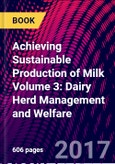”All three volumes of Achieving sustainable production of milk should be considered as a whole…Over more than 1200 pages, the authors review all fields of milk production, beginning with milk composition, genetics and breeding, safety and milk quality, sustainability of milk production as well as dairy herd management, health, welfare and nutrition of dairy. All three volumes could be considered a standard reference for graduate students in the fields of dairy science and veterinary medicine, animal and dairy scientists at universities and other research centres, and also those in governments and companies involved or working in the field of milk production.” Animal Feed Science and Technology In meeting rising demand, more intensive dairying systems face a range of challenges such as maintaining high standards of safety in the face of the continuing threat from zoonoses entering the food chain, whilst sustaining nutritional and sensory quality. At the same time farms need to become more efficient and sustainable. Finally, farming must also meet higher standards of animal health and welfare. Drawing on an international range of expertise, this book reviews research addressing the welfare, nutrition and health of dairy cattle. Part 1 begins by discussing key issues in welfare followed by topics such as genetic selection and welfare, housing and transportation. Part 2 looks at nutrition with chapters on rumen microbiology, feed evaluation and formulation, feed supplements and feed safety. The final part of the book covers aspects of health such as control of diseases and other disorders such as lameness as well as dairy herd health management. Achieving sustainable production of milk Volume 3: Dairy herd management and welfare will be a standard reference for animal and dairy scientists in universities, government and other research centres and companies involved in beef production. It is accompanied by two other volumes which review milk composition, genetics and breeding as well as safety, quality and sustainability.
Audience: Academic researchers in meat, dairy and animal science; Government agencies responsible for food safety/quality and livestock farming; Meat and dairy processors
Audience: Academic researchers in meat, dairy and animal science; Government agencies responsible for food safety/quality and livestock farming; Meat and dairy processors
Table of Contents
Part 1 Welfare of dairy cattle
Part 2 Nutrition of dairy cattle
Part 3 Health of dairy cattle








